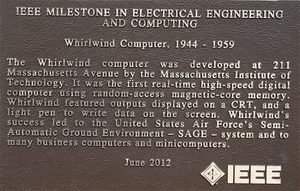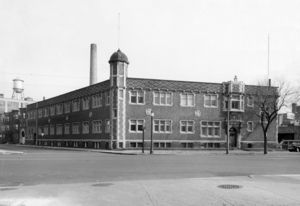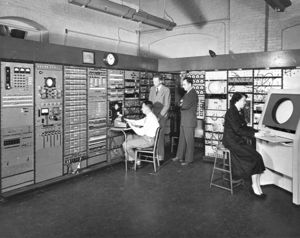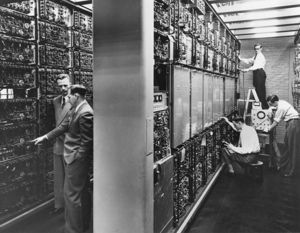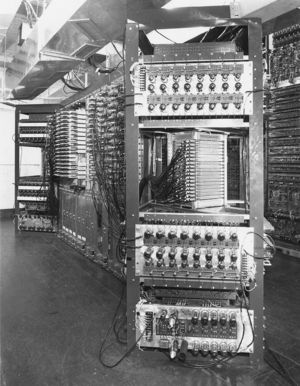Whirlwind Computer, 1944 - 1959
The Whirlwind computer was developed at 211 Massachusetts Avenue by the Massachusetts Institute of Technology. It was the first real-time high-speed digital computer using random-access magnetic-core memory. Whirlwind featured outputs displayed on a CRT, and a light pen to write data on the screen. Whirlwindʼs success led to the United States Air Forceʼs Semi Automatic Ground Environment - SAGE - system and to many business computers and minicomputers.
Street address(es) and GPS coordinates of the Milestone Plaque Sites
- Site 1: 211 Massachusetts Ave., Cambridge, MA 02139 US (42.36136, -71.09679)
- Note: this site is now part of the Novartis Pharmaceuticals campus.
- The Whirlwind computer was developed at this address. The project began in the MIT Servomechanisms Laboratory in 1944, which later split off to become the Digital Computer Laboratory and Lincoln Laboratory, Division 6. Whirlwind testing continued through 1958. In 1947, this site became the Barta Building when MIT acquired it to house the Whirlwind Computer from 1948-1959 (MIT Building N42).
- Site 2: MIT Lincoln Laboratory: 244 Wood St., Lexington, MA 02421 US (42.458626, -71.263568)
- Site entrance gate is on Wood St. at Schilling Circle
- Plaque location: Main Lobby (42.45913, -71.26700)
Details of the physical location of the plaque
- Site 1: On the building’s brick exterior immediately to the right of the large main entrance door, readily visible to pedestrians from the public sidewalk (see adjoining photo of main entrance with plaque)
- Site 2: One of 6 Milestone plaques on a display board prominently located in the Main Lobby
How the plaque site is protected/secured
- Site 1: Building security camera; the MIT campus is patrolled by MIT Police; 24/7 access
- Site 2: Building security is next to the display board; viewable during normal business hours
Historical significance
Summary: The Whirlwind computer was developed at the Massachusetts Institute of Technology (MIT) between 1945 and 1952 in a project directed by Jay Forrester. The project was first carried out in the Servomechanisms Laboratory. Later it separated to become the Digital Computer Laboratory and Lincoln Laboratory, Division 6, and testing continued through 1958. Jay Forrester served as director of both laboratories until 1956, and Robert Everett as associate director, then director. A key part of the Whirlwind design was the high-speed and highly reliable magnetic core memory for the computer storage system, replacing electrostatic storage tubes. Jay Forrester was issued a patent for the magnetic core memory, and it was used successfully and widely in large and small computers.
History: The development of Whirlwind, one of the first large-scale high-speed computers, began during World War II as part of a research project to develop a universal flight trainer that would simulate flight (the Aircraft Stability and Control Analyzer project). It was initiated by the Office of Naval Research and began at the MIT Servomechanisms Laboratory in 1944. Eventually the focus of the grant, a flight simulator, using an analog computer, changed to developing a high-speed digital computer. While building the computer, researcher Jay W. Forrester discovered random-access, coincident-current magnetic storage, which became the standard memory device for digital computers. Prior to Forrester's discovery, electrostatic storage tubes were used. The introduction and change to magnetic core memory provided high levels of speed and of reliability. By late 1951, the Whirlwind computer was operational and made available for scientific and military research. Unclassified research projects using the Whirlwind computer were managed by the Digital Computer Lab staff on the MIT campus, where Whirlwind occupied the Barta Building (N42), which had been acquired in 1947 to provide sufficient space for the computer as it was designed and constructed. In 1952 staff working on classified projects left to be part of the newly organized Lincoln Laboratory off campus, to form Division 6, Digital Computer Division. Although their projects were classified, the Whirlwind computer itself was not, and remained in the Barta Building. Jay Forrester served as director of the Digital Computer Laboratory and Division 6, Lincoln Laboratory until 1956, when he became a member of the MIT faculty pursuing interests in system dynamics in management. Robert Everett served as associate director of both labs until he succeeded Forrester as director. The U.S. Air Force provided substantial financial support for Whirlwind applications and Whirlwind was a key component in the design of the Air Force's SAGE (Semi-Automatic Ground Environment) air defense system in the 1950s. Whirlwind computer was shut down on May 29, 1959. It was disassembled and moved out of the Barta building in the spring of 1960.
Jay Forrester received a patent for magnetic core memory. The ETHW explains why: “The magnetic-core, a wire mesh of ferrite rings and metal wire, created a location where binary information could be recorded and retrieved magnetically. The ability to pinpoint specific intersections or addresses within the core rings, from which information could be stored and then recalled at random, created an unparalleled innovation in computing. The computer’s central processing unit and its memory of stored data, procedures and programs, could now be operated interactively. This interactivity boiled down to one major innovative gain: speed. Random-access memory was born.”
Further Reading
1. The complete source of documentation for the Whirlwind project during the period 1944 to 1959 is housed at MIT Archives and Special Collection MC 665. The finding aid to the collection is available on-line: Special Collection MC 665.
2. On-line references available in September 2011 http://wapedia.mobi/en/Whirlwind_(computer)
3. Reference Books
Redmond, Kent, and Thomas Smith. Project Whirlwind: The History of a Pioneer Computer. Bedford, MA: Digital Press, 1980.
Redmond, Kent, and Thomas Smith. From Whirlwind to MITRE, the R & D Story of the SAGE Air Defense Computer. Cambridge: MIT Press, 2000.
4. Additional images can be found in the Project Whirlwind Photo Archives (Archives URL no longer on Mitre website as of 4 April 2015, per Internet Archive's Wayback Machine).
Supporting Materials
- MIT's Barta Building: The Most Important Building in the History of Computing
